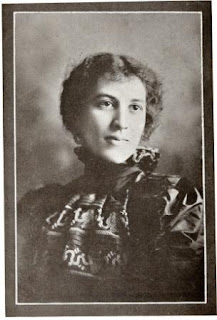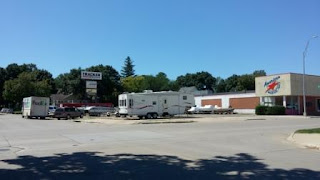One
of the houses featured in “Picturesque Algona” is that of Civil War veteran Dr.
Henry C. McCoy and his wife, Sarah.
Located at 503 E. McGregor, it is a lovely two story home. Trees surround the house as pictured in the
book with the front sidewalk enclosed in a canopy of branches. Trees still line the sidewalk today providing
ample shade.
Introducing the McCoys
Henry
C. McCoy was born in Ireland in 1839. He
came to America at the age of 12. It appears
that he was orphaned before moving to America and was sent to live with an
uncle, but conflicting information was found about this period of his
life. In any event, he lived in New York
City for a while, later settling in Wisconsin where he received his education
and began medical school. He enlisted in the 31st Wisconsin infantry
volunteers at the end of his first year of medical school. He was chosen to serve as hospital steward
for his regiment and was later made assistant surgeon of the Third Tennessee
Cavalry. He served for three years in
the army, including being captured and imprisoned at Meridan. He was honorably discharged in July of 1865.
His
wife was a native of Ireland, too, having been born Sarah Ann Patterson on
December 13, 1839. Her parents, Samuel
and Sarah Patterson, were from Antrim, North Ireland. They came to America in 1852 and settled in
Columbia County, New Jersey. Seven years
later they moved to Monroe, Wisconsin, where Sarah completed her education and
became a school teacher. It was there
she met Henry and they were married in 1864.
After
the war, Henry went on to finish his medical degree at Northwestern
University. He practiced for several
years in Footeville, Wisconsin. The
McCoys, along with their two daughters, Josephine and Louise, came to Algona in
1870.
Part of the Community
Dr.
McCoy had a lively practice while in Algona and was well respected. One of his obituaries states, “As a physician
no man was more devoted and self sacrificing.
He did not count personal ease or comfort when he could do anything for
his patients.” The doctor had several
different offices downtown and for a period shared office space with Dr.
Garfield. However in 1897 he moved his
office to his home.
The
McCoys were a welcome addition to the life of the community. He was very active in the G.A.R. both at the
local level where he was tireless worker and at the national level where he was
appointed aide de camp to the national commander three times. Sarah devoted much of her time to the Women’s
Relief Corps helping Civil War veterans and their families. Dr. McCoy served on the board of the public
library and he also worked to attract manufacturing enterprises to Algona and
actively sought out railroad companies to secure the best service to the
community. He was an active democrat and
in 1884 ran for congress from this district.
Well known in state political circles, he was mentioned as a candidate
for the office of lieutenant governor a few years later.
In
1886 the doctor was presented with a beautiful gold-headed ebony cane by his
friends in recognition of all of his service to the community of Algona. The
presentation came as a complete surprise to the humble doctor who was so
overcome by emotion that he was only able to utter a simple “Thank you.” That cane became one of his most highly
prized possessions.
The
McCoys’ two daughters brought much love and affection to their parents and made
the house a joyful place. Josephine, the
oldest affectionately known as Josie, and her sister, Louise, were not quite
two years apart in age, but were enrolled in school together graduating from
Algona High School in 1886. They both
were exceptional students and later became teachers. Both girls attended the Northern Iowa Normal
School and University of Minnesota.
Josie spent some time studying in the Minneapolis Conservatory of Music. Louise went on to obtain her master of
literature degree from the University of Minnesota.
Heartbreak
The
girls were very close – almost inseparable.
They were able to secure positions at the same school in Lake City,
Minnesota, for their first year of teaching during the school year of
1893-4. Well loved by their students,
the young women enjoyed their tenure there.
Toward the end of the school year, however, tragedy struck.
The
two sisters were invited one evening by two young men to accompany them on a
boat ride on Lake Pepin. Lake City is
located on the western shore of that lake.
It was a lovely still evening and the surface of the lake was perfectly
smooth. Josie was accompanied in one
boat by Mr. Walter Holmes who was a cashier of Merchant’s Bank of Lake City and
Louise rode in a separate boat with the other man. The boats became separated after a while and
Mr. Holmes began to row across to the Wisconsin side of the lake. Josie decided that she wanted to try her hand
at rowing when they were about a half mile from shore. At the same time she stood up to change
seats, another boat went by, causing a wake which capsized the boat.
The
two were able to place an oar across the boat as it lay in the water. Josie grabbed one end and Holmes the
other. They shouted for help and Holmes
even fired a pistol, but to no avail.
The icy water caused hypothermia to set it and Josie complained of
numbness and cramping. She struggled to maintain
until she could no longer hold on and she sank beneath the water. Holmes managed to keep his hold on the boat
and he was later rescued.
Louise
had returned to their boarding house around 9 p.m. At first she was not
distressed that Josie had not yet returned, but by 11 p.m. she was
frantic. Organizing a group to search
the shore, nothing was found. It wasn’t
until 8 o’clock the next morning that Louise received the terrible news. Although very little hope of finding the body
was given, experienced searchers dragged the lake and at 5 o’clock that
afternoon, Josie’s body was recovered.
Henry
and their pastor, Rev. W. E. Davidson, traveled to Lake City and brought Louise
home along with Josie’s remains. The
funeral was conducted from the McCoys’ residence. The home was filled with flowers including a
special design of tea roses entitled “Gates Ajar,” from her students at Lake
City.
The Family Moves On
Josie’s
sudden passing cast a pall of grief over every member of the family. Louise could no longer bear to teach at Lake
City and it was at this time that she decided to go back to school for her
master’s degree. She then took a
position as principal of the high school at Waseca, Minnesota from 1896 to 1901.
Dr.
and Mrs. McCoy attempted to return to their life as best they could. Sarah turned to her work as a volunteer at
the Congregational Church and the Women’s Relief Corps to give her purpose. Henry continued the practice of medicine and
his volunteer efforts as well.
It
was in March of 1901 that Dr. McCoy made a sixteen-mile ride in the country to
visit a patient. By the time he returned
home, he was not feeling well and took to his bed. The illness quickly turned into pneumonia,
followed by heart trouble. Henry C.
McCoy passed from this life on March 19, 1901.
His funeral was held at the house and was largely attended. Both the G.A.R. and the Masonic Lodge sent
delegations and in honor of his many years of service on the board, the public
library closed on the day of his service.
He was buried in Riverview Cemetery next to Josie.
 |
| Louise McCoy |
With
her mother now widowed, Louise came back to Algona. She was appointed to take her father’s place
on the library board and in 1902 began teaching in the high school. Miss McCoy soon became a favorite
teacher. She organized the debating team
and instituted the class play. She spent
many evenings directly working with declamatory students and created the Delta
Sigma for training in extemporaneous speaking.
During the flu epidemic in 1919 Louise contracted influenza which
damaged her heart and left her in a weakened state. For two years her health continued to
decline, until she died on October 11, 1921, once again shrouding the house in
sadness.
Sarah
McCoy now found herself all alone. She moved to the home of her brother, James Patterson, here in Algona where she lived
until the following May, when she passed away at the age of 82. She was buried in the family plot at
Riverview Cemetery beside the rest of her family members.
Although
not survived by any descendants, the McCoy family has not been forgotten in
Algona. Their name lives on.
Until
next time,
Jean
(a/k/a Kossuth County History Buff)
If you enjoyed this
post, please don’t forget to “like” and SHARE to Facebook. Not a Facebook
user? Sign up with your email address in the box on the right to have
each post sent directly to you.
Be sure to visit the
KCHB Facebook page for more interesting info about the history of Kossuth
County, Iowa.
Reminder: The posts on Kossuth County History Buff are ©2015-16 by Jean
Kramer. Please use the FB “share” feature instead of cutting/pasting.














